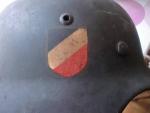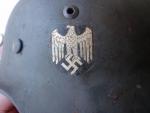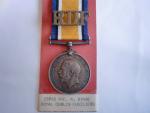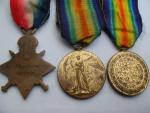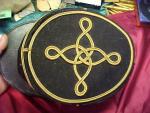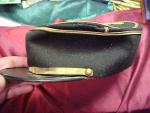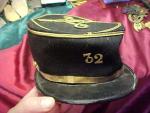
renmore
For Deletion-
Posts
21 -
Joined
-
Last visited
Content Type
Profiles
Forums
Blogs
Gallery
Events
Store
Everything posted by renmore
-
Heer German Helmet
renmore replied to renmore's topic in Germany: Third Reich: Uniforms, Headwear, Insignia & Equipment
Thanks Paul for the help. -
Heer German Helmet
renmore replied to renmore's topic in Germany: Third Reich: Uniforms, Headwear, Insignia & Equipment
-
I am hoping some kind fellow members will help me out on this helmet, its outside my collecting area and I need help, the story attached to it is that it was brought back in 45 by a British Army officer who lived near me, he passed away 30 years ago and the current owner received the helmet from the Major 40 years ago when he was 10.So, the provenance seems good but I need an expert opinion for the current owner, any help would be gratefully received.The markings are ET66 and 3648 near the rear, there is also a painted inscription, Viehl (I presume a surname) and then Pz.S.Stabskp. Best regards, Renmore
-
Dub in the Rising 1916
renmore replied to renmore's topic in Great Britain: Orders, Gallantry, Campaign Medals
Thanks timo, you did indeed see it on boards.I have to say your trio to McIntosh is a cracker,a great find, well done. -
This is just a single BWM but it belonged to a man who had experienced two momentous events in Irish History, The Great War and the Easter Rising of 1916, and he also had the misfortune to be wounded in both.I had the good fortune to find Pte. Byrnes service record on Ancestry and gather the following information. Pte Michael Byrne was a 28 year old postman from The Demense,Lucan,Co. Dublin who enlisted into the 10 Batt RDF on the 21/1/1916 stating his Mother Annie of the same address as his NOK.He stood 5ft 6ins with a 38in chest. The 10th Batt. were a newly formed service Batt. formed from the Commercial Company of the 5th Batt RDF. They were dubbed the Commercial Pals but there are references to them being also called "Redmonds Shopkeepers" by local wits.Some of the recruits may also have been members of Redmonds National Volunteers, and would have had previous military training. By the 24/4/1916 the 10th were stationed at Royal Barracks,Dublin,(Now Collins Barracks).Approx 37 officers and 430 men of the 10th were in the barracks that day when Rebel forces occupied key buildings around Dublin, when rifle fire was heard around the city some companies of the 10th were mobilised for action. The RDF had their first contact with the Rebels at the Medicity Institute where the rebels were led by Captain Sean Heuston and 15 men who were to prevent and delay crown forces from relieving Dublin Castle.Byrne was most likely wounded in this or a subsequent action as his SR states he received bullet wounds to the chest, abdomen, and arm on the 24/4/16 in the Dublin Rebellion.Further notes from his SR refer to 6 puncture wound from shrapnel, and his addmission to King George V Hospitial Dublin on the 13/5/16 with GSW's (various).Newspaper reports from the period suggest Byrne was first treated at the Meath Hospital. Pte. Byrne appears to have made a full recovery as he was with his battalion when it went to France on the 18/8/16 Where they joined 190th Infantry Brig of the 63rd royal Naval division.September and October was spent learning trench warfare and preparing for the next offensive.This came on the 13th of November when the battalion went in to action with the 63rd Div in the battle of the Ancre, over the next 3 days the battalion suffered 242 casualties from an initial attacking force of 493 officers and men.I dont know whem Michael Byrne was wounded but he was in the 3rd Canadian general Hospitial on the 15/11/16 with a shrapnel wound to his back.He was shipped back to England on the 18/11/16 to recuperate at the Cambridge Hospital ? Aldershot (SR hard to decipher). Byrne never went back into action but did attend bombing and anti gas school at Otley on two occasions in 1917/18 and finished the war with the rank of L/Serjeant,(or is that an appointment?)Byrne was discharged on the 21/2/1919 and his character was described as very good, he was entitled to the BWM and VM.All in all a fascinating journey for an Irish soldier
-
Brothers in the Dubs.
renmore replied to renmore's topic in Great Britain: Orders, Gallantry, Campaign Medals
You're right PK, they most likely went to the smelter,some people were quite poor in the 70's and the money was tempting, but you never know they might turn up, I live in hope.Glad to see you gave the brothers Hunt a piece of your mind,they deserved it.I have a few more bits to the Dubs and other Irish regiments, which I will post in the next few days. Renmore. -
Brothers in the Dubs.
renmore replied to renmore's topic in Great Britain: Orders, Gallantry, Campaign Medals
-
14 star and VM to Pte.Michael Hannon 8864 RDF KIA 3/5/1915. VM to Pte.William Hannon RDF 24626 sentenced to death 9/11/1916. Unfortunately both brothers BWM,s are missing. Ireland in 1914 was a nation divided, the majority of its people wanted an Irish parliament. The third Home Rule Bill was soon to be read before the House of Commons. Ulster Unionists were steadfast in their opposition to Irish Home Rule, and civil war threatened the nation of Ireland. This crisis however was “ overshadowed by greater one caused by an assassin’s bullets at Sarajevo”(1). Germany had breached Belgium’s neutrality and on the 4th of August 1914, Great Britain declared war on Germany. John Redmond was the leader of The Home Rule Party at the time, and believed Ireland should support England in the war effort. It was commonly believed that this would be a short war and that Great Britain would be victorious, upon which Ireland and its people would be rewarded with Home Rule for their loyalty. The War, however was not a short campaign and many Irish men were to fight and die in The Great War. In Brannockstown, Co. Kildare, two brothers were destined to fight in this war; Michael and William Hannon. The older, Michael Hannon would be killed in action on 3rd May 1915(2). The younger brother William Hannon joining the same regiment as his brother just six months after he was killed on the 8th November 1915(3). The following is an account of each brothers journey through the war, extrapolated from their individual service records and regimental movements during their active duty. As of August/September 1914, The British Expeditionary Force (BEF) contained fourteen Irish units. Among these units was the 2nd battalion of The Royal Dublin Fusiliers, who were part of the 10th Infantry Brigade within the 4th Division(4). Michael Hannon was a member of the 2nd Royal Dublin Fusiliers, one of many infantry men. Towards the end of July 1914, most of the armies regular battalions were either on training exercises or in barracks, the BEF had approximately 70,000 all arms, with no less than 15,000 of those being Irish(5). The 4th division were dispatched on the 21st of August 1914 and landed in Boulogne Northern France on the 22nd of August(6). As the first engagement of the war was taking place, The Battle of Mons, the 4th Division were making their way north into Belgium. The British had fought well against a larger German army,(their casualties had amounted to just over 1,600 while the German losses were in excess of 5,000)(7). The British force now had to withdraw and did so efficiently. As the British withdrew, they were being hotly pursued by the German first army. The 4th division along with Hannon’s 2nd battalion were taken by train to the village of Le Cateau, they proceeded to march north where the eventually encountered a large German army and were outnumbered three to one(8), “ it is said by some that through the course of the entire war, never were British troops as heavily outnumbered”(9). The British, once again fought remarkably well and managed to hold off the larger German force. Hannon’s battalion also suffered heavy losses during the intense fighting. The battalion which initially consisted of twenty two officers and one thousand and twenty three other ranks, were whittled away to ten officers and four hundred and seventy eight other ranks(10). Through a combination of military training and indeed some luck Michael Hannon was amongst these men who survived. On the night of the 26th of August the allies withdrew to Saint Quentin just south of the Belgian border, in the north of France. The British had suffered great losses, 7,812 of all ranks killed, wounded or missing, and 38 field guns were lost(11). An interesting event which took place involving Hannon’s battalion was the so called ‘Colonels Surrender’ at Saint Quentin. It is suggested that the two Lieutenant Colonels Mainwaring and Elkington had promised the Mayor of Saint Quentin that they would not fight in the town and if they could not evacuate their men before the arrival of the Germans, they would surrender(12). Mainwaring maintained that he faced a mutiny situation amongst his men, the 2nd Royal Dublin Fusiliers. However “ Mainwaring was the only member of his unit to be tried by court martial, suggesting either that references to a mutiny amongst the 2nd R.D.F are exaggerated or that the military authorities were sympathetic to the problems endured by the troops during the retreat from Mons”(13). This incident seems to indicate a conspiracy to mutiny by the 2nd R.D.F., however with the court martial of the Colonel, perhaps the weary troops were just following orders. The main aim of the B.E.F was to get its troops moving again, and they did. Hannon and the rest of the 4th division proceeded to advance towards Marne in North- Eastern France. 4th division was now to be organised into the III Corps alongside 19th brigade and 6th division. Concentrated just north of Melun(south of Paris), the three corps were ordered to make a general advance. The III corps was on the extreme left of the British line, with the 4th division having most Irish units including Hannon and the 2nd R.D.F.(14).There were heavy losses on both sides in the first Battle of the Marne, mostly within the French and German armies. The allies were to be the victorious side, with the Germans eventually retreating and any hopes they had for a quick victory evaporating also. The end of this battle marked the beginning of trench warfare as a four year stalemate was to ensue. Hannon along with the rest of the 2nd R.D.F and 4th division had by now endured nearly a month of extreme and unrelenting fighting, and yet the hardest battles were yet to be fought. The next engagement for the 2nd R.D.F came in early October 1914, when they were tasked with assisting in the taking of the village of Meteren( French Flanders). However due to confused orders and directions they had arrived after the village had been taken. The 2nd R.D.F now moved to hold the line north of Armentieres, near the village Ploegsteert, six miles south of the town of Ypres(Belgian Flanders). Here they endured many German attacks, and launched their own counter-attacks, but the line remained static as the trend of trench warfare evolved. The Germans will and capacity to attack was now expended and both sides were now preparing defensive fortifications. The Dubliners settled themselves into trench life even though sniping and surprise bombardments were the order of the day. Hannon and the 2nd R.D.F had a brief respite from the war when they were one of the units involved in the famous 1914 Christmas truce, when they exchanged gifts and fraternised with the German troops in no mans land in front of Ploegsteert wood(15). In early January the Dubliners were withdrawn from the line and the unit rested at Nieppe(North France) until the end of March. They then moved “to a new line River Douve to the Wulverghen Messins Road”(16).(Located in French/Belgian Flanders). By the 23rd of April Hannon and the troops moved to the outskirts of Ypres and took position west of the St. Julien road. The Germans began to attack, which included heavy bombardments and tear-gas. Meanwhile, Hannon and the 2nd R.D.F joined a larger force consisting of ten battalions and were ordered to retake St. Julien. They began to advance in the early morning in ‘faultless order’ until they were 100 yards from the outskirts of St. Julien.(17). All battalions suffered heavy losses with the 2nd R.D.F losing 510 all ranks, killed or wounded, nevertheless ‘some elements of the Dublins actually succeeded in getting into the village’(18). Here the battalion were ordered to hold their line and dig in, “they held these positions under heavy bombardment until 4th May”(19). Michael Hannon was killed in action on 3rd May 1915(20), no doubt under an artillery assault from the Germans. Hannon and the 2nd R.D.F had endured many battles and hardships, especially when trench warfare began. Hannon was no doubt a highly skilled soldier and survivor, however the luck of the Irish was not on his side this day. For his service to the B.E.F, Hannon was awarded the 1914 Mons Star, The British War Medal and Victory Medal*(21). Michael Hannon was 33 years of age when he died and is remembered at Ypres Menin Gate Memorial(22). It was only six months after Michael Hannon’s death when his younger brother William decided to join the British Army. Michael had been a regular soldier most of his life and was in one of the armies regular battalions. William, however would join one of the reserve battalions, the 5th, of the Royal Dublin Fusiliers. Much more information is available on William’s actual circumstances when joining, as his service record is far more detailed then that of Michael’s. His war campaign turns out to be extremely different to that of his brothers. William Hannon signs up to join the British Army on the eighth of November 1915 at Naas, a roman catholic man aged just 24, and previously having worked as a Garden Labourer(23). At the time, the general public would have been aware that this was not a short campaign and that British Army and allied losses were substantial. Battles from the trenches was the trend and line movement was minimal. What persuaded William Hannon to want to be a part of this dire situation? Perhaps family tradition dictated he join the war effort, or maybe personal reasons motivated him, a sense of retribution, a willingness to fight in the name of his dead brother, Michael. John Redmond was encouraging young Irish men to join the effort, in the hope of a Home Ruled Government, perhaps this persuaded William. So William joined the 5th reserve battalion and began training. The 5th (extra reserve) battalion, was at this time (November 1915) in training at the Curragh(24). He and his fellow volunteers were to be in training for over nine months until they saw any action. On the 26th August 1916, W. Hannon was drafted into the 7th battalion of the R.D.F, as part of the 10th(Irish) Division, making up part of the Salonica Expedition Force(25). Salonica was the capital city of Macedonia, the largest region within Greece, it was here on the 9th September 1916 that W. Hannon and his battalion landed. This was to be the main base of operations for the allies against pro- German Bulgaria. Also on the agenda was “Repair of old roads and construction of new ones, along with roads, bridges and railways… this work continued until 10th Division left Macedonia”(26). At this time battalion strengths were depleted, as the effects of malaria were devastating to the 10th division, and soldiers were badly needed to hold their front. W. Hannon was to see his first action on the 3rd October 1916 when his battalions brigade(30th Brigade) was ordered to capture the town of Yenikoi, assisting in a general assault across the Struma river(Bulgaria/Greece)(27). Following half hour’s worth of bombardment, 7th R.D.F,6th R.D.F, and 7th Munsters attacked Yenikoi. Within an hour Yenikoi had been captured(28).Although the capture had been quick, a counter attack was inevitable. The Bulgarians initiated heavy bombardment, directed against Yenikoi. During this bombardment, along with some wayward friendly fire the 6th and 7th R.D.F suffered heavy casualties-” the two Dublin battalions suffered heavily, not only from enemy artillery but also from ’unders’ from their own”(29). As the battalions were forced back from the line, others came to reinforce. The two R.D.F battalions kept possession of the village through the night, and next morning Yenikoi was fortified. During this period 10th Division took many casualties through a combination of malaria and those wounded or killed in action. This resulted in a “long period of inactivity…the battle against mosquitoes and the training began again”(30). William Hannon, however was not to remain long with 10th Division and the 7th R.D.F. On the 9th November 1916, W. Hannon was tried by field general court martial, and sentenced to death, for falling asleep while acting as a watching sentinel(31). This sentence would be reduced to five years penal servitude, and then eventually suspended as he would be re-deployed by May the following year. One can only imagine what William Hannon had to endure along with the rest of the troops during the battle of Yenikoi. W. Hannon joined up with a severely depleted Division torn apart by the effects of malaria, and troops exhausted from on going manual labour. After the battle of Yenikoi the R.D.F battalions had been hit hard not only by enemy artillery, but unfortunately by their own comrades. After a hectic few days of fighting, and then the task of rebuilding, W. Hannon along with many others would have been exhausted. Perhaps these factors were the reason his sentence was reduced and eventually suspended, or maybe the British just needed to keep re-cycling men to Europe as their casualties grew. Whatever reason, the initial shock of a death sentence would have hit William Hannon hard, after volunteering to serve the British Army. William Hannon was shipped back to England in January 1917 to begin his five years penal servitude in Maidstone prison, Kent(32). After many suspension requests, and the necessary paper work was concluded, William Hannon was released from Prison on the 12th May 1917, under orders from the Army Council(33). From here he rejoined the 5th battalion of the R.D.F, after serving just over 140 days in prison, a far cry from the original sentence of death. After two weeks, on the 26th of May 1917, W. Hannon was posted to the 10th battalion R.D.F under command of the 190th Brigade in 63rd(Royal Naval) division(34). This division was located in France and Flanders during its service, however W. Hannon was with the 10th R.D.F for just under a month and saw no action during this time. From here W. Hannon joined the 1st R.D.F within the 29th Division on the 10th June 1917. The 29th Division was also situated along Northern France and Flanders. With this division, W. Hannon fought in the Battle of Passchendaele near the town of Ypres in west flanders Belgium. The 29th Division were involved in several battles between June and October. The fighting was fierce and the appalling conditions didn’t help the British advance. The land consisted of reclaimed marshland and rain thickened the mud in which troops had to fight. This was one of the most costly battles of the war and hundreds of thousand of troops were lost on both sides. The main battle, however for W. Hannon and the 1st R.D.F was to come on the 4th of October at Broodseinde. They were ordered to join the 16th(Irish) division and to make an ‘advance of a 1000 yards on a two company frontage’(35). The 1st R.D.F, made a great effort on this day, and many men were lost in gaining their objective, 340 all ranks killed and wounded, including William Hannon who was wounded on this day, a shrapnel wound caused by an artillery shell, to the right thigh(36). One of the men W. Hannon was fighting alongside on this day was a Sgt. Ockenden, a heroic man who had rushed an enemies machine-gun crew and killed all but one. He also “single-handedly captured a farm and took sixteen prisoners”(37). For these brave actions Ockenden was to be one of only three men within the Royal Dublin Fusiliers regiment who won a Victoria Cross. Following W. Hannon’s wound he was sent home on the 21st of October, no doubt due to the seriousness of the wound. He did not rejoin the war and ended up being honourably discharged on the 29th of June 1918, quoted as “being of good character”(38). He was 26 years and 8 months of age, having served just over two and a half years in the British Army. For his service W. Hannon won the British War medal, The Victory Medal and was awarded the Silver War Badge for being wounded in action(39). The journey undertaken by these two brothers was indeed a remarkable one, each of them having endured the full scale of The Great War. Each man courageous in his own right and no doubt having fought valiantly on the battlefield. Thankfully the Hannon family did not lose two sons throughout the war. Having each of the brothers war medals in my possession is what inspired me to write about their journey, and the battles they each fought to win the medals. The stories and battles of each man is unique but at the same time typical of that of any Irish soldier who fought in The Great War. Endnotes:(Bracketed numbers) 1:Johnstone , Orange, Green and Khaki, p 9 2:www.ancestry.co.uk ( British army military record search) 3:www.ancestry.co.uk (British army WW1 military service records) 4:Johnstone, Orange, Green and Khaki, p5. 5:Johnstone, Orange, Green and Khaki, p6. 6: http://www.1914-1918.net/dubs.htm 7: http://www.1914-1918.net/dubs.htm 8: http://www.greatwar.ie/ire_batbrd.html 9: http://www.1914-1918.net/bat2.htm(John Lucy, 2nd Royal Irish Rifles, ‘There’s a devil in the drum’.) 10:http://www.greatwar.ie/ire_batbrd.html 11: http://www.1914-1918.net/bat2.htm 12:Bowman, The Irish Regiments in the Great War, p48. 13:Bowman, The Irish Regiments in the Great War, p49. 14:Johnstone, Orange, Green and Khaki, p36. 15: http://www.1914-1918.net/truce.htm 16:Westlake, British Battalions On the Western Front, January to June 1915,p238. 17:Johnstone, Orange, Green and Khaki, p75 18:Johnstone, Orange, Green and Khaki, p75 19:Westlake, British Battalions On the Western Front, January to June 1915,p238. 20:www.ancestry.co.uk ( British army military record search) 21:www.ancestry.co.uk ( Medal index card search) 22:http://www.cwgc.org/search/casualty_details.aspx?casualty=908800 23: http://www.ancestry.co.uk(British military service record, WW1) 24: http://www.1914-1918.net/dubs.htm 25: http://www.ancestry.co.uk(British military service records, WW1) 26:Johnstone, Orange, Green and Khaki, p257. 27:Johnstone, Orange, Green and Khaki, p262/3. 28:Johnstone, Orange, Green and Khaki, p263. 29:Johnstone, Orange, Green and Khaki, p263. 30:Johnstone, Orange, Green and Khaki, p265. 31:www.ancestry.co.uk (British military service records). 32:www.ancestry.co.uk (British Military service records). 33:www.ancestry.co.uk (British Military service records). 34:http://www.1914-1918.net/dubs.htm 35:Johnstone, Orange, Green and Khaki, p298-9. 36: http://www.ancestry.co.uk(British military service records). 37:Johnstone, Orange, Green and Khaki, p298-9. 38: http://www.ancestry.co.uk(British military service records). 39:www.ancestry.co.uk (British Medal index card).copyright scawley
-
I was wondering if anybody can give an approx date of manufacture/use for this kepi that I recently aquired.the numerals are metal and the maker is Delion,rue de Capucins Paris, it has artillery buttons and is to the rank of adjutant,any help would be very welcome. Best Regards, Renmore
-
Republic of Ireland Modern Irish Defence Force Awards
renmore replied to Ceallach's topic in Northern European & Baltic States
Many thanks to all the contributors on this thread,this was a topic that I had very little information about.

